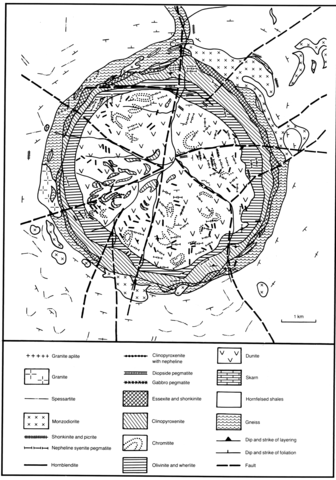stripes
Konder is an almost perfectly circular intrusion which cuts Archaean schists, gneisses and marbles that are overlapped by Sinian (Proterozoic to lower Cambrian) sandstones and siltstones 450 m in thickness. The Sinian rocks are domed and Marakushev et al. (1991) discuss the formation of this dome and the emplacement of the early ultramafic rocks. Ultramafic rocks form the central stock and are surrounded by a ring intrusion of syenites, diorites and monzonites. There is a clear zonality to the massif (Fig. 235) with, from the centre to the margins, the following sequence: (1) Dunites dominate the central area and vary from coarse porphyritic varieties at the centre, with olivine phenocrysts of 2-3 mm diameter, to medium-grained dunites at the margin. Lenses of chromitite from 10 cm to 1 m thick are widespread in the dunites. In the southeastern part of the dunite core subparallel bodies of biotite pyroxenite with apatite (koswite) are concentrated, 24 such bodies having been identified in one 140 m section. (2) The outer part of the ultramafic stock consists of medium- and fine-grained olivinites. (3) An intermediate zone 8-10 m wide is composed of olivinites and clinopyroxenites. (4) Fine- and medium-grained pyroxenites. (5) The outer part of the complex is composed of essexites and shonkinites. The dunites are generally fine- and medium-grained rocks of dark green and green hues; on weathered surfaces they are greenish-yellow. Compositionally they are rather homogenous; in addition to olivine (80-96%, forsterite-chrysolite), they usually contain fine-grained and scattered chromite impregnation (up to 1-2% chrome picotite with Cr2O3 values up to 51.5%) and 3- 20% serpentine. Pyroxenites are medium- and coarse-grained rocks which are dark green to almost black. They are built mainly of clinopyroxene (diopside-salite with 10% of hedenbergite molecule) and by a small amount of titanomagnetite (up to 5%). The koswites are fine- and medium-grained, massive rocks of clinopyroxene (56- 77%), titanomagnetite (11-20%), hornblende (0-11%), biotite (0- 21%) and accessory apatite, titanite and secondary chlorite. Apatite-biotite-titanomagnetite-pyroxene rocks form isolated occurrences amongst the dykes and veins of koswite and a large field in the centre of the complex; they are also recorded as small bodies within the dunites, pyroxenites and peridotites. The modal proportions of minerals vary widely with clinopyroxene 20- 50%, biotite 15-40%, titanomagnetite 20-40% and apatite 5-15%. The rocks are medium- to giant-grained with biotite crystals 10x10x3 cm. In some areas occur veins up to 1 cm thick of chrysocolla. Diorites and monzosyenite of the external ring zone, with a width up to 700 m, are medium- and fine-grained rocks with a porphyritic textures. They consist of andesine (54-77%), microcline and orthoclase (0-20%), hornblende (6-23%), clinopyroxene (0-1.5%), biotite (1-5%) and quartz (0-7%), as well as accessory apatite, titanite and magnetite and secondary chlorite, sericite, and carbonate. There are dykes of nepheline syenite, nepheline pyroxenite, melteigite and nepheline syenite pegmatite. The following varieties of alkaline pegmatites have been identified: aegirine-arfvedsonite-feldspar with lamprophyllite, eudialyte, ramsayite and murmanite, as veins up to 6-7 m thick; aegirine-albite with ramsayite; arfvedsonite- zeolite with titanite; arfvedsonite-zeolite with ilmenite. As an example the composition of the first pegmatite type is aegirine (20-30%), arfvedsonite (20-30%), orthoclase (30-40%), eudialyte (1-2%), lamprophyllite (2-3%), murmanite (1%) and apatite (1-2%). A group of limestones at the margin of the complex were once considered to be carbonatites but these were later demonstrated to be skarns, a brief account of spinel- and perovskite-bearing examples of which is given by Orlova et al. (1981). Detailed accounts of the compositions of the rocks and minerals of Konder can be found in the paper by Andreyev (1987), and Lazarenkov and Malich (1992) give analyses, including platinum group elements, of the ultramafic rocks. Using iron-titanium oxides from a wide range of rocks Ardontsev and Malich (1989b) calculated temperatures and oxygen fugacities at the time of crystallization.
ANDREYEV, G.V. 1987. The Konder ultrabasic alkaline massif. Nauka, Novosibirsk. 76 pp.
ARDONTSEV, S.N. and MALICH, K.N. 1989a. Geodynamic model of the formation of the massifs of the Konder complex. Geologiya I Geofizika. Novosibirsk, 7:‚ 27-33.
ARDONTSEV, S.N. and MALICH, K.N. 1989b. Physicochemical conditions of iron-titanium oxide formation in rocks of the Konder alkalic ultramafic pluton. Transactions (Doklady) of the USSR Academy of Sciences, Earth Science Sections, 296: 225-7.
BOGOMOLOV, M.A. 1968. Apatite-bearing rocks of the Konder massif. In. O.H. Vorob'eva and V.P. Petrov (eds) Apatite. 224-7. Nauka, Moscow.
EL'YANOV, A.A. and MORALEV, V.M. 1961. New data on the age of the ultramafic and alkaline rocks of the Aldan shield. Doklady Akademii Nauk SSSR, 141:‚ 686-9.
LAZARENKOV, V.G. and MALICH, K.N. 1992. Geochemistry of the ultrabasites of the Konder platiniferous massif. Geochemistry International, 29: 44-56.
MARAKUSHEV, A.A., YEMEL'YANENKO, Ye.P., NEKRASOV, I.Y, MASLOVSKIY, A.N. and ZALISHCHAK, B.L. 1991. Formation of the concentrically zoned structure of the Konder alkalic-ultrabasic pluton. Transactions (Doklady) of the USSR Academy of Sciences, Earth Science Sections, 311: 69-72.
ORLOVA, M.P. 1991. Geologic structure and genesis of the Konder ultramafic massif (Khabarovsk Territory). Pacific Geology, 1: 80-8.
ORLOVA, M.P., BAGDASAROV, E.A. and SOSEDKO, T.A. 1981. Spinel and perovskite from rocks of the exoskarn zone of the Konder massif (Khabarovskiy Kray). International Geology Review, 23: 716-20.
ORLOVA, M.P., ARDONTSEV, S.N. and SHCHADENKOV, E.M. 1986a.
Alkaline magmatism of the Aldan shield and its specific mineralogical features. In I.M. Frumkin (ed) Geology and geochemistry of the ore-bearing magmatic and metasomatic associations from the Maly BAM area. 4-12. Yakutia Branch of the
Siberian Division of the USSR Academy of Sciences, Yakutsk.
SHEINMANN, U.M., APELTSIN, F.R. and NECHAEVA, E.A. 1961. Alkaline intrusions, their distribution and related mineralisation. In A.I. Ginzburg (ed) Geology of the deposits of the rare elements. Gosgeoltekhizdat, Moscow. 177 pp.

